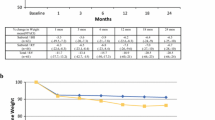To date, longitudinal weight loss analyses (curve-fitting) have been complicated by non-linear weight patterns, incomplete follow-up, and varied follow-up times. Therefore, the cross-sectional design (one time point survey) was chosen to study predictors of weight loss at yearly postoperative time intervals (± 6 months). Mean values for the initial cohort of 7,540 patients were: age 37.4 years (± 9.4), weight 124.0 kg (± 25.5), height 165.4 cm (± 8.5). Females comprised 87.7% of the data set. Followup was 62.5% at year one, 32.0% at year 2, 20.6% at year 3, and 15.4% at year 4. The multiple regression model used included 20 explanatory variables and was performed separately for four yearly time points. Only operative weight, initial visit height, age, and operative type were consistent predictors of weight loss (p < 0.05) at all time points examined and accounted for 40-50% of weight loss variation.
Similar content being viewed by others
Author information
Authors and Affiliations
Consortia
Rights and permissions
About this article
Cite this article
Jeng, G., Renquist, K., Doherty, C. et al. A Study on Predicting Weight Loss Following Surgical Treatment for Obesity. OBES SURG 4, 29–36 (1994). https://doi.org/10.1381/096089294765558863
Published:
Issue Date:
DOI: https://doi.org/10.1381/096089294765558863




